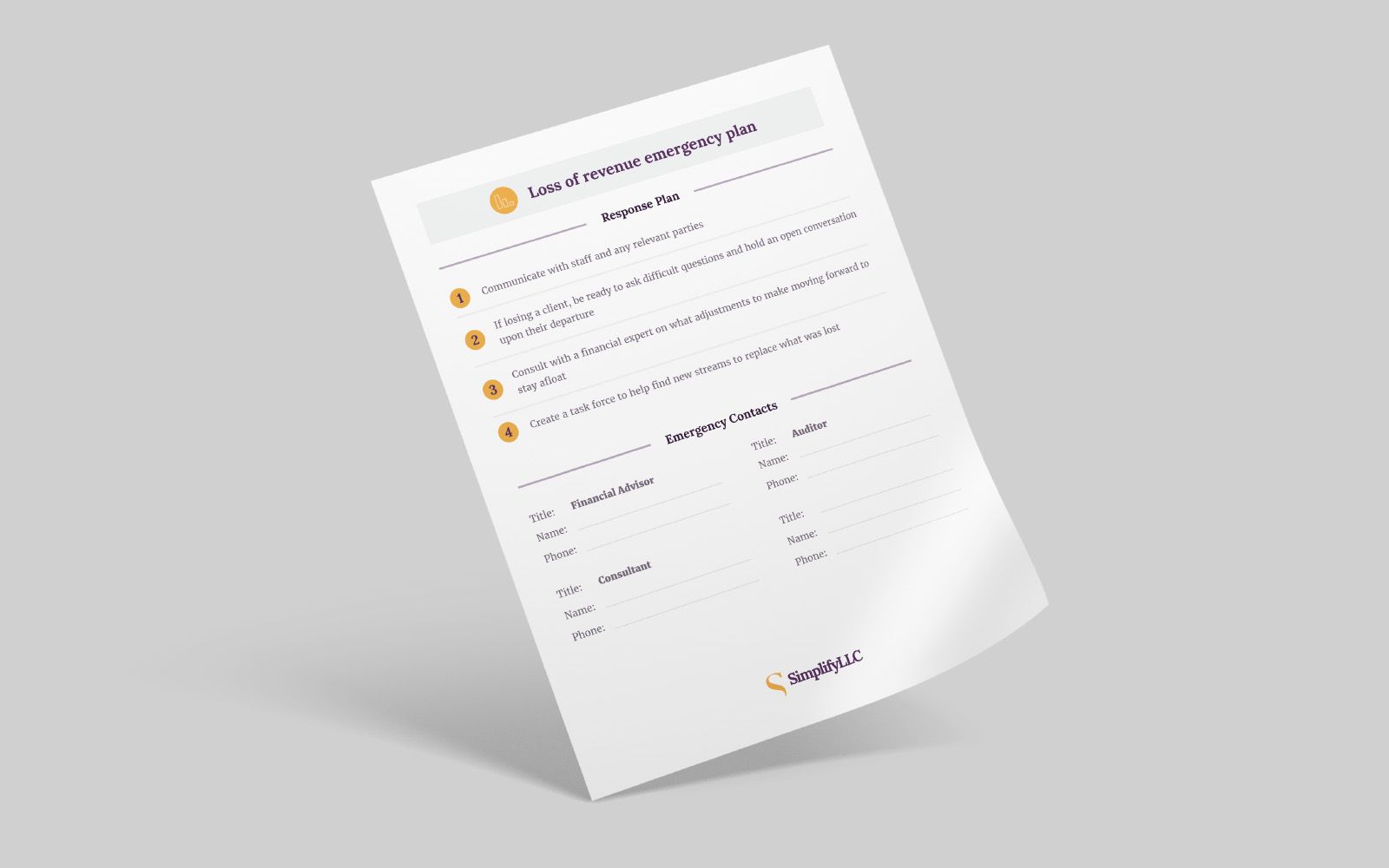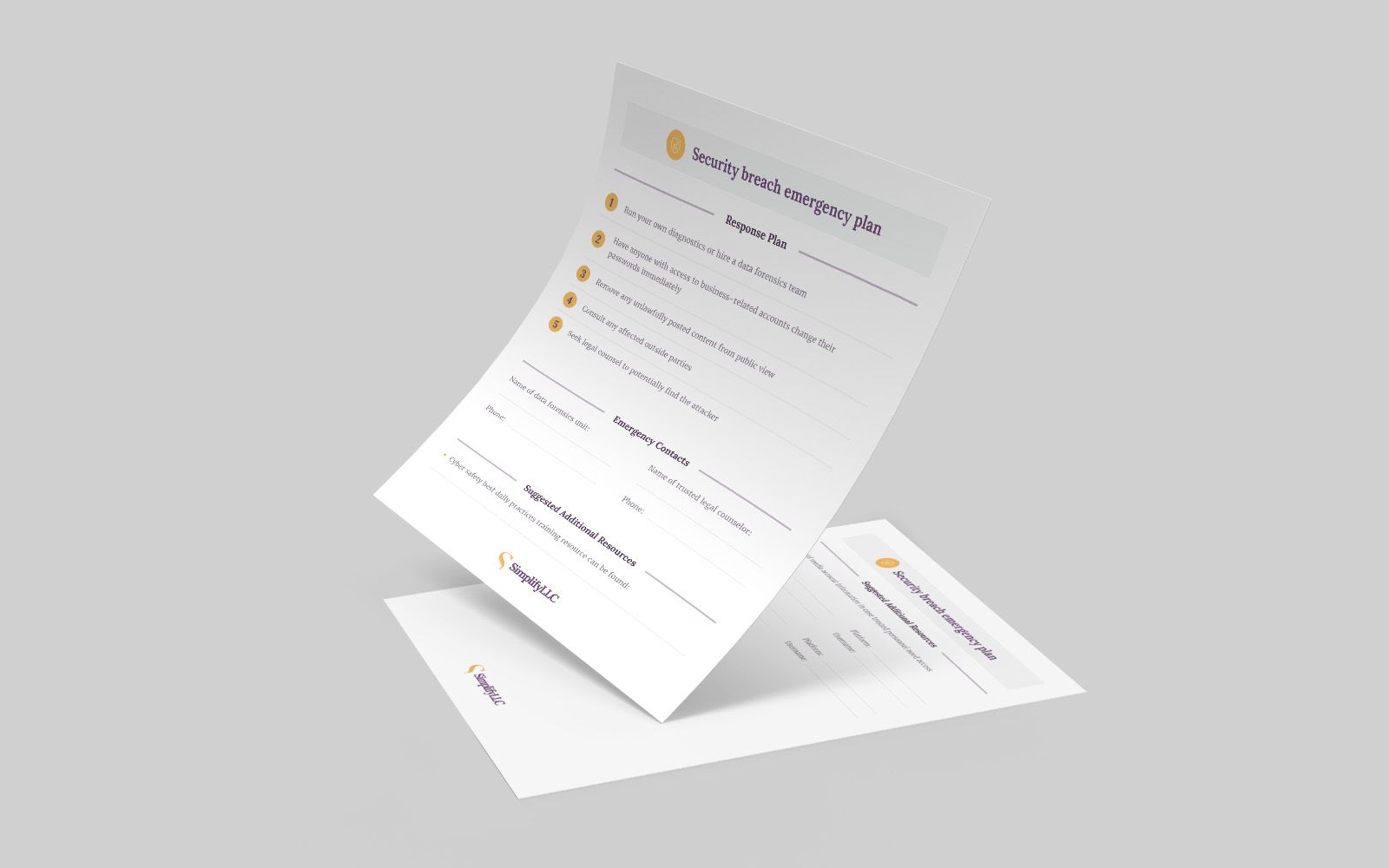An emergency can impact your business at any time.
Whether a natural disaster strikes, you lose significant staff members or you face a personnel-related accident, having a thorough business emergency preparedness plan is essential.
While you might not be able to avoid the emergency entirely, you can prevent any unnecessary extra damages.
This guide will explain creating the best business disaster preparedness plans and offer some printable templates to get you going.
Plus, we share some tips to keep in mind while you get everything together.
Table of contents
- How to create an emergency preparedness plan
- 5 essential tips for emergency response
- Common emergency situations and how to combat them
- Natural disasters
- Loss of staff members
- Loss of significant source of revenue
- Security breaches
- Personnel-related hazards
- Additional resources
How to create an emergency preparedness plan
It can be difficult knowing what to nail down first when learning how to prepare for an emergency situation. Conducting in-depth risk assessment and planning for speedy disaster recovery is critical.
Step 1: Assess the potential risks your industry can face
Certain businesses are more susceptible to specific kinds of emergencies than others.
For example, if your business is impacted by hurricane season, prepping for potential storms is essential. If your business’s day-to-day involves special equipment, acquaint yourself with the possible risks that may occur.
Become as knowledgeable as possible and move forward with your plan from there.
Step 2: Gather local, state, and federal resources
Many local, state and federal resources are available to business owners in need of emergency assistance.
The Federal Emergency Management Agency (FEMA.gov) is an excellent resource for small business owners. Likewise, many state and federal agencies have disaster loans business owners can apply for.
In the event of a disaster, doing the research beforehand is more helpful than struggling at the last minute.
Be sure to organize these resources by emergency type if applicable to keep everything easily accessible. Keep a digital copy of your running log saved on a trusted device and store any physical copies in safe, secure file storage.
Step 3: Create unique plans of action for different emergencies
The course of action for responding to a personnel accident will differ from the response to revenue loss.
While there may be general tips you can follow in the face of an emergency, the safest bet is to create unique, specified plans for every situation, so you’re as prepared as possible no matter what strikes.
5 essential tips for emergency response
There are a few things to keep in mind when building an emergency plan for your business. Your response will directly impact how your business continues once the dust settles.
- Keep plans of action and resources updated consistently
- Practice transparency and clear communication
- Keep a list of emergency contacts
- Make sure your staff is trained well in the proper emergency response
- Try to stay flexible and adapt the plan once the emergency has occurred
Common emergency situations and how to combat them
Emergencies can present themselves in many different circumstances. Let’s dive into some of the potential scenarios you may run into as a business owner.
Natural disasters
Natural disasters include but are not limited to hurricanes, earthquakes, flooding, tornadoes, and blizzards.
While natural disasters can be difficult to predict, there are usually times of the year when they’re more likely to occur. Familiarize yourself with peak seasons to have a plan in place beforehand.
Preventative tips
Some helpful disaster preparedness tips to stay ahead in the face of a natural disaster include:
- Stay informed during peak seasons to anticipate as much as possible
- Invest in weather-proof adjustments to your workplace, such as shutters, weather-resistant windows, and climate-proof storage
- Have a generator for your workspace in case you lose power
Plan of action
If a natural disaster is approaching your business, have an evacuation plan ready and highlight the safest routes for you and your staff.
Even if there isn’t a need for evacuation or shelter-in-place, allow staff to work from home to reduce the risk of getting stuck in the middle of a disaster during their commute.
Keep digital copies of important documents and protect any physical documentation in weather-proof storage.
In extreme cases, be ready to halt all operations and close down until the coast is clear. Check your business’s insurance coverage to avoid paying out of pocket for any damages.
Ideally, you would have looked into purchasing comprehensive insurance policies ahead of time.

Loss of staff members
If your business has grown to have a significant amount of staff, sometimes you'll lose essential team members along the way. You can lose employees through voluntary resignations, staff reductions for budget reasons, or having to fire someone.
Preventative tips
Like other emergency situations, losing staff members isn’t entirely preventable but can be avoided.
- Maintain a healthy company culture to encourage staff retention
- Diversify revenue streams to keep profit flow so you can avoid budgetary layoffs
- Keep a clear code of conduct so everyone is aware of what constitutes a fireable offense
Plan of action
When there's a staff change, practice effective crisis communication and alert the company as soon as possible to avoid gossip and speculation.
You’ll want to assess what caused the loss to help guide your next steps. If this was a budgetary layoff, sit down and carefully analyze your finances.
If this was a resignation, conduct an exit interview with the departing employee to see where you potentially have room for improvement. For staff members who have been laid off or fired, provide outplacement programming.

Loss of significant source of revenue
Losing a stream of revenue is a serious business interruption. Depending on your business model, different occurrences can cause a significant source of income to fall through. Maybe a large client discontinues their partnership unexpectedly.
Perhaps you’re unable to restock a popular product that brings in a lot of profit.
Preventative tips
There are a few ways to proactively try to reduce the risk of losing a significant source of revenue.
- Hold regular client and stakeholder meetings, so everyone is on the same page
- Thoroughly track inventory to make sure things are properly stocked
- Hire someone to keep a close eye on your business’s finances
Plan of action
After the loss of a significant source of revenue, be transparent and have communication plans to alert staff and stakeholders of the situation.
A good business owner won’t leave anyone in the dark. If losing a client, be ready to ask them difficult questions and hold an open conversation upon their departure.
Consult with a financial expert on what adjustments to make moving forward to stay afloat.
Stay motivated to keep business in motion after the fact. Create a task force to help find new streams to replace what was lost and build a business continuity plan.

Security breaches
Living in the digital age has its advantages but also comes with its risks.
Having important documents leaked or employee personal information compromised constitutes a severe security breach. Comprehensive emergency management is essential in these situations.
Preventative tips
Prevention starts with making sure all staff members are well-versed in the best practices for their day-to-day security.
Review websites like ready.gov for up-to-date cybersecurity information.
- Provide cybersecurity training to employees and a comprehensive toolkit on how to respond to individual threats
- Invest in backup and cloud software, so if anything is compromised, there are unaltered copies
- Only use well-reviewed apps and software with a well-functioning support team, and monitor the software employees download onto devices
Plan of action
In the unfortunate situation your business encounters a security breach, first run some of your own diagnostics or hire a data forensics team to see exactly what has been affected and how.
Next, you’ll have anyone with access to business-related accounts change their passwords immediately to avoid multiple incidents.
Check social media and other public domains to see if any company material was shared.
Remove any unlawfully posted content from public view.
Consult any affected outside parties, whether other businesses or individuals, to alert them of the situation and your recovery plans. Seek legal counsel to potentially find the attacker.

Personnel-related hazards
Having a supportive, hardworking staff makes all the difference, but working with people brings its risks.
If the pandemic has taught us anything, widespread illness can significantly affect the workplace. If your staff has to operate machinery or use dangerous tools, it’s essential to have a preparedness program in place for workplace accidents.
Preventative tips
- Provide proper training for personnel who have to use hazardous equipment as part of their job
- Give ample paid time off and sick days so no one worries about running out of days in the face of an emergency
- Keep a well-stocked first-aid kit with over-the-counter medicines and other items such as bandages, gauze, hand sanitizer, and tissues
Plan of action
First, you’ll want to assess the severity of the situation.
Has anyone been seriously injured requiring hospitalization? Has someone started showing symptoms of a severe illness? Discern whether it’s time to call 911.
In the meantime, be sure everyone knows where to find a first aid kit.
If this is a sickness-related issue, send the affected party home. Contact the affected party’s listed emergency contact and communicate what’s going on and how it’s being handled.
Finally, assess the business impact of having displaced staff members.

Additional resources
You can never be too prepared for an emergency. If you’re stuck where to find additional resources, reference the organizations’ tips and best practices.
- Small Business Association (SBA)
- Department of Homeland Security
- Center for Disease Control
- Red Cross
- Score
Hopefully, your business can thrive without having to experience an emergency of any kind.
Creating a well-thought-out business emergency preparedness plan is of the utmost importance.
If you’re struggling with how to manage a specific situation, consult seasoned business owners in your community for how they’ve made it through.




